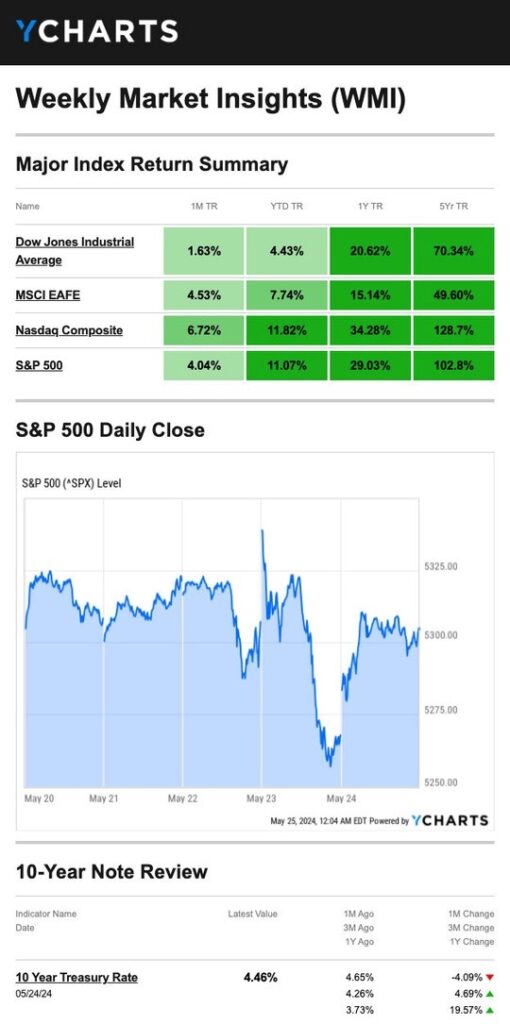
Last week’s stock performance was mixed, following investors’ reaction to the Fed’s May meeting minutes, while a handful of mega-cap tech companies created a buzz with their news.
Market Splits
Stocks began trading in a narrow band last week. Still, mega-cap tech names rallied in anticipation of the Q1 corporate report from a key company that makes semiconductors for artificial intelligence (AI). The enthusiasm lifted the Nasdaq to fresh records.
Federal Reserve news mid-week unsettled investors, who reacted to Federal Open Market Committee meeting notes that stated some Fed officials worried over the lack of progress on inflation.1
Technology was the sole winning group for the whole week, with all other Standard & Poor’s 500 industry sectors ending in the red.2


Source: YCharts.com, May 25, 2024. Weekly performance is measured from Monday, May 20, to Friday, May 24.
TR = total return for the index, which includes any dividends as well as any other cash distributions during the period.
Treasury note yield is expressed in basis points.
Bucking the Trend?
One of the handful of companies bucking the trend last week was Nvidia.
The semiconductor maker – the fifth largest company in the S&P 500 by market capitalization, thanks to their prominent role in AI – reported that its Q1 sales tripled from a year ago. The company also announced a 10-to-1 stock split. The news pushed its market cap to over $2 trillion.3
The companies mentioned are for informational purposes only. It should not be considered a solicitation for the purchase or sale of the securities.
To some on Wall Street, Nvidia is the bellwether for the AI industry. By one estimate, the entire AI market is nearly $300 billion for this year – more than 3X the market’s size of $95 billion just three years ago. By 2030, that estimate may reach $1.8 trillion.4
Remember that forecasts rely on assumptions and may undergo revisions over time. Financial, economic, political, and regulatory issues may cause the actual results to differ from the expectations expressed in the forecast.
This Week: Key Economic Data
Tuesday: Consumer Confidence. Case-Shiller Home Price Index. Fed Official Loretta Mester speaks.
Wednesday: Beige Book. Survey of Business Uncertainty. Fed Official John Williams speaks for the first time during the week.
Thursday: GDP. Jobless Claims. International Trade in Goods. Pending Home Sales. Fed Official John Williams speaks again.
Friday: Personal Income and Outlays. Fed Official Raphael Bostic speaks.
Source: Investors Business Daily – Econoday economic calendar; May 23, 2024
The Econoday economic calendar lists upcoming U.S. economic data releases (including key economic indicators), Federal Reserve policy meetings, and speaking engagements of Federal Reserve officials. The content is developed from sources believed to be providing accurate information. The forecasts or forward-looking statements are based on assumptions and may not materialize. The forecasts also are subject to revision.

“Appreciation is a wonderful thing. It makes what is excellent in others belong to us as well.”
– Voltaire



Employee vs Independent Contractor: Classifying Those Who Work for You Appropriately
Classifying workers as independent contractors or employees is essential for several tax reasons. The basis for this classification has two primary considerations: control and relationship.
Control refers to how much of the person’s work you control; this encompasses the completed work, its execution, and whether you control the financial aspects of the person’s job. In this manner, “control” means both behavioral and financial control.
Another critical factor is the relationship between the employer and the worker. How both parties perceive this relationship can guide you in determining the worker’s status. Some factors that influence relationships include the following.
- Written contracts that describe the relationship the parties intended to create.
- Whether the business provides the worker with employee-type benefits, such as insurance, a pension plan, vacation, or sick pay.
- The permanency of the relationship.
- The extent to which services performed by the worker are a pivotal aspect of the company’s regular business.
- The extent to which the worker has unreimbursed business expenses.
Classifying your workers is essential because independent contractors and employees face different tax needs and implications.
*This information is not intended to be a substitute for specific, individualized tax advice. We suggest that you discuss your specific tax issues with a qualified tax professional.
Tip adapted from IRS.gov5

How to Take a Vacation Without Leaving Home
Vacations provide many benefits and are ideal for relaxing and taking a break from everyday stressors. But sometimes, you can’t swing a whole vacation. The good news is that you can still enjoy a little getaway without leaving the comfort of your own home.
Here are some fun ways to “get away” without actually getting away:
- Create a themed cocktail or drink based on the place you’re dreaming of. Whip up a fancy French cocktail and pretend you’re sitting on a terrace in Paris; order a local microbrew from a US destination you’ve always wanted to visit.
- You can also host a themed dinner night and take a culinary adventure worldwide. Bonus points if you design an authentic menu.
- Visit a museum (virtually). The Google Arts and Culture Project lets you visit the Tate, Reina Sofia, and Acropolis Museums from home.
Tip adapted from Ideas.ted.com6
1. The Wall Street Journal, May 22, 2024
2. Sectorspdrs.com, May 24, 2024
3. The Wall Street Journal, May 22, 2024
4. Statista.com, May 24, 2024
5. IRS.gov, January 24, 2023
6. Ideas.ted.com, January 24, 2023
Investing involves risks, and investment decisions should be based on your own goals, time horizon, and tolerance for risk. The return and principal value of investments will fluctuate as market conditions change. When sold, investments may be worth more or less than their original cost.
The forecasts or forward-looking statements are based on assumptions, may not materialize, and are subject to revision without notice.
The market indexes discussed are unmanaged, and generally, considered representative of their respective markets. Index performance is not indicative of the past performance of a particular investment. Indexes do not incur management fees, costs, and expenses. Individuals cannot directly invest in unmanaged indexes. Past performance does not guarantee future results.
The Dow Jones Industrial Average is an unmanaged index that is generally considered representative of large-capitalization companies on the U.S. stock market. Nasdaq Composite is an index of the common stocks and similar securities listed on the NASDAQ stock market and is considered a broad indicator of the performance of technology and growth companies. The MSCI EAFE Index was created by Morgan Stanley Capital International (MSCI) and serves as a benchmark of the performance of major international equity markets, as represented by 21 major MSCI indexes from Europe, Australia, and Southeast Asia. The S&P 500 Composite Index is an unmanaged group of securities that are considered to be representative of the stock market in general.
U.S. Treasury Notes are guaranteed by the federal government as to the timely payment of principal and interest. However, if you sell a Treasury Note prior to maturity, it may be worth more or less than the original price paid. Fixed income investments are subject to various risks including changes in interest rates, credit quality, inflation risk, market valuations, prepayments, corporate events, tax ramifications and other factors.
International investments carry additional risks, which include differences in financial reporting standards, currency exchange rates, political risks unique to a specific country, foreign taxes and regulations, and the potential for illiquid markets. These factors may result in greater share price volatility.
Please consult your financial professional for additional information.
This content is developed from sources believed to be providing accurate information. The information in this material is not intended as tax or legal advice. Please consult legal or tax professionals for specific information regarding your individual situation. This material was developed and produced by FMG Suite to provide information on a topic that may be of interest. FMG is not affiliated with the named representative, financial professional, Registered Investment Advisor, Broker-Dealer, nor state- or SEC-registered investment advisory firm. The opinions expressed and material provided are for general information, and they should not be considered a solicitation for the purchase or sale of any security.
Copyright 2024 FMG Suite.



